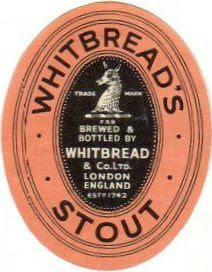Their main brand was London Stout, which came in both draught and bottled form. Costing, respectively, 7d and 8d per pint in the public bar. (If you bought a crate of four quart bottles, the price was just 7.5d per pint.) At least at the outbreak of war. Tax increases soon pushed that price upwards.
Some brewers, such as Barclay Perkins heavily primed their Stouts, raising the effective OG by as much as 3º or 4º. Whitbread didn’t record primings in their brewing records, but, by cross-referencing with analyses of the finished beers, it appears they didn’t prime their Stouts, not even the draught version.
As was typical, the OG was eroded in the first half of the war and was stable for the remainder. Though, at just 3.5% ABV, it wasn’t very “stout” for the latter part of the war.
You can see the impact of government-dictated reductions in hop usage which kicked in during 1941. By the end of the war, with restrictions loosened, the hopping rate bounced back a little. The effect is also seen in the calculated IBUs. But remember that it’s just my calculation, not a measured value. Add the extra uncertainty of having to factor in the age of the hops and it’s even more of a guesstimate.
The colour paled across the war, simply due to the reduction in gravity and hence the quantity of malt employed.
| Whitbread London Stout 1939 - 1945 | ||||||||||
| Date | Year | OG | FG | ABV | App. Atten-uation | lbs hops/ qtr | hops lb/brl | calc. IBU | colour (EBC) | Pitch temp |
| 8th Aug | 1939 | 1046.9 | 1013.0 | 4.48 | 72.28% | 6.89 | 1.28 | 31 | 330 | 62º |
| 9th Sep | 1940 | 1043.4 | 1012.5 | 4.09 | 71.20% | 6.90 | 1.27 | 29 | 320 | 62º |
| 22nd Sep | 1941 | 1042.0 | 1011.5 | 4.03 | 72.62% | 5.57 | 1.02 | 21 | 300 | 62º |
| 4th Aug | 1942 | 1038.7 | 1011.0 | 3.66 | 71.58% | 6.64 | 1.11 | 23 | 330 | 62º |
| 31st May | 1943 | 1039.6 | 1012.5 | 3.59 | 68.43% | 6.28 | 1.11 | 23 | 285 | 64º |
| 22nd Sep | 1944 | 1039.8 | 1013.5 | 3.48 | 66.08% | 6.55 | 1.15 | 23 | 250 | 64º |
| 19th Sep | 1945 | 1039.2 | 1012.5 | 3.53 | 68.11% | 6.14 | 1.09 | 23 | 285 | 64º |
| Sources: | ||||||||||
| Whitbread brewing records held at the London Metropolitan Archives, document numbers LMA/4453/D/09/126, LMA/4453/D/09/127, LMA/4453/D/09/128 and LMA/4453/D/09/129. | ||||||||||

Primings were subject to duty, so how did they get away with not recording them in the logs? Unless they weren't priming any of their beers at all.
ReplyDeleteBarm,
ReplyDeleteprimings are recorded in several different ways. Sometimes as if they were brews on their own in brewing logs. Sometimes, I guess, in separate documents. But I'm sure that they were always recorded and taxed.